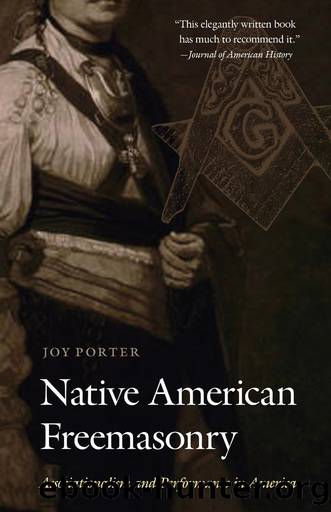Native American Freemasonry: Associationalism and Performance in America by Joy Porter

Author:Joy Porter
Language: eng
Format: epub
Publisher: University of Nebraska Press
Published: 2019-11-04T00:00:00+00:00
Denslow then adds to Mackeyâs outline of notable Indian Masons by providing details of Masonryâs significance in a long list of Indian lives, men such as the âhonoraryâ Creek Cherokee revolutionary war leader William Augustus Bowles (Estajoca, ca. 1764â1805), the Choctaw leader Peter P. Pitchlyn, the Cherokee supreme court judge David Carter, and Pushmataha (1764â 1824), the Choctaw military and spiritual leader and diplomat. Masonic history in Indian Territory owed most to the Cherokee, and so Denslow devotes space to those noted men involved with its first lodge: John Ross and his nephew William P. Ross; David Carter, lodge treasurer; and G. W. Adair, John S. Vann, J. Foreman, and J. M. Lynch. He goes on to list noted Creek Masons, including the supreme judge George W. Stidham and the mixed-blood Creek Seminole Brig. Gen. Alexander McGillivray (Hippo ilk Mico, 1750â93). Consistently he avoids commenting on the forced removal of Indian communities these mid-nineteenthcentury Indian Masons were much involved with, or that removal (or as Denslow terms it, ârelocationâ) occurred in spite of the fact that some of these communities and their leadership had heavily assimilated American mores. Instead removal is presented as a sad inevitability and the factionalism that arose among Indian communities as a result of broken treaties due to âold wounds.â Freemasonic principles and influence are put forward as Indian communitiesâ âgreatest healer.â For Denslow, Masonry in Indian Territory is somehow wholly separate from the suffering and death that resulted from forced migration imposed by American authorities. It is an unmitigated good epitomized by heartwarming stories of compassionate American Masonic soldiers sharing their rations with starving Indian families.24
Although published in 1956, Denslowâs book teems with the sort of social evolutionary thinking that informs its two main anthropologist-archaeologist protagonists, the Seneca Iroquois Arthur Caswell Parker (1881â1955) and his fraternal brother and friend Alanson Buck Skinner (1886â1925). Alongside much discussion of what the author calls âthe Red Manâs mindâ we learn, for example, that only the most intelligent Indians had the good sense to become Freemasons: âThe more intelligent Indians came from a limited number of nations. First were the Iroquois of upper New York; another group was the Five Civilized Tribes that were moved bodily from the southeast United States to Oklahoma Territory. These Indians readily adapted themselves to Freemasonry and hundreds of them were initiated into the order in early years.â25
Both Parker and Skinner were dedicated Freemasons, Skinner within the York Rite and Parker within the Scottish Rite, where he gained its highest degree, the thirty-third, conferred only by election by the bodyâs Supreme Council. Both learned their intellectual orientation from F. W. Putnam of the American Museum of Natural History in New York and from the work of the social evolutionist (and play-Indian fraternalist) Lewis Henry Morgan (1818â81). Skinner wrote extensively on Indian spirituality and culture, with a particular focus on the Menominee of Wisconsin, and worked for the American Museum of Natural History and later for the Museum of the American Indian, Heye Foundation, New York.
Download
This site does not store any files on its server. We only index and link to content provided by other sites. Please contact the content providers to delete copyright contents if any and email us, we'll remove relevant links or contents immediately.
| Baha'i | Cults |
| Demonology & Satanism | Eckankar |
| Egyptian Book of the Dead | Freemasonry |
| Messianic Judaism | Mysticism |
| Scientology | Theism |
| Tribal & Ethnic | Unitarian Universalism |
The Four Agreements by Don Miguel Ruiz(5534)
Breaking Free by Rachel Jeffs(3631)
The Hatha Yoga Pradipika (Translated) by Svatmarama(2501)
120 Days of Sodom by Marquis de Sade(2448)
Member of the Family by Dianne Lake(2038)
The Tao of Physics by Fritjof Capra(1861)
The Psychedelic Gospels: The Secret History of Hallucinogens in Christianity by Jerry B. Brown(1830)
The Road to Jonestown by Jeff Guinn(1746)
Uriel's Machine by Christopher Knight(1627)
Going Clear by Lawrence Wright(1579)
Going Clear: Scientology, Hollywood, and the Prison of Belief by Lawrence Wright(1576)
The Grand Grimoire: The Red Dragon by Author Unknown(1420)
The Gnostic Gospel of St. Thomas by Tau Malachi(1417)
Key to the Sacred Pattern: The Untold Story of Rennes-le-Chateau by Henry Lincoln(1353)
The Malloreon: Book 02 - King of the Murgos by David Eddings(1311)
Waco by David Thibodeau & Leon Whiteson & Aviva Layton(1298)
The New World Order Book by Nick Redfern(1260)
The Secret of the Temple by John Michael Greer(1223)
The Initiatory Path in Fairy Tales by Bernard Roger(1180)
